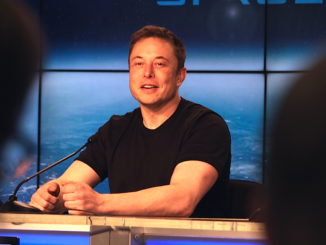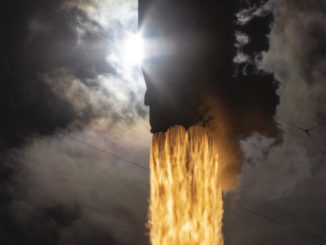
With a robot rather than a cosmonaut in the commander’s seat, a Russian Soyuz spacecraft rocketed into orbit from Kazakhstan late Wednesday (U.S. time) en route to the International Space Station on a critical test flight before crews begin riding an upgraded Soyuz booster next year.
A Soyuz-2.1a rocket fired into a clear sky over Site 31 at the Baikonur Cosmodrome in Kazakhstan at 11:38:32 p.m. EDT Wednesday (0338:32 GMT; 8:38:32 a.m. local time Thursday), right on time to launch on a trajectory to intercept the space station.
The kerosene-fueled launcher arced toward the east-northeast from Baikonur, shedding its four first stage boosters and launch escape system less than two minutes after liftoff. An aerodynamic shroud later released from the Soyuz spacecraft, and the Soyuz core stage shut down and fell away nearly five minutes into the mission.
On-board video views showed the rocket’s staging events occurring as intended, and a third stage RD-0110 engine powered the Soyuz MS-14 spacecraft into orbit. The capsule deployed from the third stage nearly nine minutes into the flight, and the Soyuz MS-14 spacecraft’s solar arrays and navigation antennas unfurled moments later, just as they would on a mission carrying a crew to the space station.
But the Soyuz MS-14 spaceship launched without a crew — the first Soyuz crew craft to fly without cosmonauts in 33 years — to allow Russian engineers to conducted a fully automated test flight. The experimental mission was conceived to test the compatibility of the Soyuz spacecraft with the upgraded Soyuz-2.1a booster, a modernized variant of the venerable Russian rocket family that is slated to begin launching crews next March.

The Soyuz-2.1a rocket variant has launched dozens of times since 2004, including ten flights with Progress cargo freighters on missions to resupply the space station.
But one of the Progress supply ships launched on a Soyuz-2.1a booster in April 2015 went into an uncontrolled spin after separating from the Soyuz third stage. Russian engineers traced the failure to a botched deployment of the Progress spacecraft from the Soyuz third stage.
The 2015 Progress accident prompted Russian officials to fly the first Soyuz crew capsule on a Soyuz-2.1a rocket without people aboard.
The Soyuz-FG variant currently used to launch Soyuz crews to the space station is set for retirement later this year.
One more Soyuz-FG rocket remains in Russia’s inventory, and it is scheduled to launch Sept. 25 carrying the Soyuz MS-15 spacecraft into orbit with commander Oleg Skripochka, NASA co-pilot Jessica Meir and flight engineer Hazzaa Ali Almansoori, set to become the first person from the United Arab Emirates to fly in space.
The Sept. 25 launch of the Soyuz MS-15 spacecraft is the final planned mission to lift off from Site 1 at Baikonur, the same facility used on the launch of Yuri Gagarin on humanity’s first orbital flight in April 1961.
Beginning next March, Soyuz crews will launch on Soyuz-2.1a boosters from Site 31 at Baikonur, which is outfitted for the upgraded Soyuz-2 family.
The Soyuz-2.1a’s upgrades include a modernized digital flight control system, replacing the analog guidance system on older Soyuz models, along with improvements to engine injection systems.
The digital control system allows the Soyuz-2.1a rocket to execute a roll program a few seconds after liftoff to reach the correct azimuth to align its flight path with the space station’s orbit. The Soyuz-FG rocket currently used to launch Soyuz crews has to be rotated into the correct orientation on the launch pad before liftoff.
After its successful ride into space, the Soyuz MS-14 vehicle will raise its altitude and match its orbit with the space station, setting up for a docking with the Poisk module at 0530 GMT (1:30 a.m. EDT) Saturday.

Instead of a crew, the Soyuz MS-14 spaceship is hauling 1,450 pounds (657 kilograms) of cargo to the space station, including the Russian Skybot F-850 robot, a two-legged, two-armed humanoid stand-in for a cosmonaut commander.
Skybot F-850 sat in the Soyuz MS-14 spacecraft’s center seat during launch, holding a Russian flag in one hand. Soon after reaching orbit, an in-cabin video feed showed the robot turning its head side-to-side.
The Skybot F-850 will not manipulate any flight controls during the Soyuz mission, but sensors on the robot’s body will measure key parameters — such as acceleration, vibrations, temperature and humidity — during the flight, including launch, docking and landing.
Alexander Bloshenko, a science advisor at Roscosmos, said the Skybot F-850 robot will conduct experiments at the space station prepared by Russian engineers.
Russian cosmonaut Alexander Skvortsov will work with Skybot F-850 after it arrives at the station. Skvortsov will be able to communicate with the robot, according to Roscosmos.
Cosmonauts will move Skybot F-850 will into the space station for five days of experiments and tests, before returning the robot to the Soyuz capsule for the trip back to Earth, according to Rob Navias, a NASA spokesperson.
Measuring nearly 6 feet (1.8 meters) tall and weighing about 350 pounds (160 kilograms), Skybot F-850 will replicate the movements of Skvortsov during a series of tests in orbit. If the tests are successful, Russia could launch upgraded robots that could work outside the space station, helping crews with tasks on spacewalks, or allowing cosmonauts to avoid spacewalks altogether, Bloshenko said.
The Skybot F-850 robot is an evolution of Russia’s FEDOR series of robots, which engineers originally developed for rescue operations. Videos from ground testing have shown the FEDOR robot shooting guns, lifting weights and driving a car.
The Russian Foundation for Advanced Research Projects, with a role similar to DARPA in the U.S. government, led the development of the FEDOR robot. FEDOR stands for Final Experimental Demonstration Object Research.
Skybot F-850 is not the first robot to travel to the space station.
NASA’s experimental Robonaut 2 robot launched to the station in 2011, but the robot returned to Earth last year in need of repairs. Robonaut 2 could return to the space station later this year.
Roscosmos created a Twitter account for the Russian robot set to fly to the station, complete with tweets composed from Skybot F-850’s point-of-view.
In one tweet, it wrote that conditions inside the Soyuz MS-14 spacecraft were tight. The robot can “barely fit among the cargo in the cabin” of the spaceship, the tweet said.
The Soyuz MS-14 spacecraft will remain at the space station for more than 13 days. The spaceship — with Skybot F-850 — will undock from the Poisk module at 2:13 p.m. EDT (1813 GMT) on Sept. 6, heading for a parachute-assisted landing in south-central Kazakhstan at 5:35 p.m. EDT (2135 GMT).
Navias said the Soyuz MS-14 spacecraft will also test new systems during re-entry and landing, which could pave the way for Russia to develop a payload return vehicle based on the Soyuz design.
SpaceX’s Dragon spacecraft is currently the only vehicle capable of returning significant cargo to Earth from the space station. There is limited room for crews to bring home equipment or experiment specimens inside the cramped Soyuz descent module.
Email the author.
Follow Stephen Clark on Twitter: @StephenClark1.



